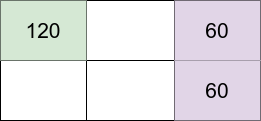LeetCode-in-Java
1659. Maximize Grid Happiness
Hard
You are given four integers, m, n, introvertsCount, and extrovertsCount. You have an m x n grid, and there are two types of people: introverts and extroverts. There are introvertsCount introverts and extrovertsCount extroverts.
You should decide how many people you want to live in the grid and assign each of them one grid cell. Note that you do not have to have all the people living in the grid.
The happiness of each person is calculated as follows:
- Introverts start with
120happiness and lose30happiness for each neighbor (introvert or extrovert). - Extroverts start with
40happiness and gain20happiness for each neighbor (introvert or extrovert).
Neighbors live in the directly adjacent cells north, east, south, and west of a person’s cell.
The grid happiness is the sum of each person’s happiness. Return the maximum possible grid happiness.
Example 1:

Input: m = 2, n = 3, introvertsCount = 1, extrovertsCount = 2
Output: 240
Explanation: Assume the grid is 1-indexed with coordinates (row, column).
We can put the introvert in cell (1,1) and put the extroverts in cells (1,3) and (2,3).
-
Introvert at (1,1) happiness: 120 (starting happiness) - (0 * 30) (0 neighbors) = 120
-
Extrovert at (1,3) happiness: 40 (starting happiness) + (1 * 20) (1 neighbor) = 60
-
Extrovert at (2,3) happiness: 40 (starting happiness) + (1 * 20) (1 neighbor) = 60
The grid happiness is 120 + 60 + 60 = 240.
The above figure shows the grid in this example with each person’s happiness. The introvert stays in the light green cell while the extroverts live on the light purple cells.
Example 2:
Input: m = 3, n = 1, introvertsCount = 2, extrovertsCount = 1
Output: 260
Explanation: Place the two introverts in (1,1) and (3,1) and the extrovert at (2,1).
-
Introvert at (1,1) happiness: 120 (starting happiness) - (1 * 30) (1 neighbor) = 90
-
Extrovert at (2,1) happiness: 40 (starting happiness) + (2 * 20) (2 neighbors) = 80
-
Introvert at (3,1) happiness: 120 (starting happiness) - (1 * 30) (1 neighbor) = 90
The grid happiness is 90 + 80 + 90 = 260.
Example 3:
Input: m = 2, n = 2, introvertsCount = 4, extrovertsCount = 0
Output: 240
Constraints:
1 <= m, n <= 50 <= introvertsCount, extrovertsCount <= min(m * n, 6)
Solution
@SuppressWarnings("java:S107")
public class Solution {
private static final int NONE = 0;
private static final int INTROVERT = 1;
private static final int EXTROVERT = 2;
private int maxHappiness(
int index,
int m,
int n,
int introverts,
int extroverts,
int board,
int[][][][] dp,
int tmask) {
if (index >= m * n) {
return 0;
}
if (dp[index][introverts][extroverts][board] != 0) {
return dp[index][introverts][extroverts][board];
}
int introScore = -1;
int extroScore = -1;
if (introverts > 0) {
int newBoard = ((board << 2) | INTROVERT) & tmask;
introScore =
120
+ adjust(board, INTROVERT, n, index)
+ maxHappiness(
index + 1,
m,
n,
introverts - 1,
extroverts,
newBoard,
dp,
tmask);
}
if (extroverts > 0) {
int newBoard = ((board << 2) | EXTROVERT) & tmask;
extroScore =
40
+ adjust(board, EXTROVERT, n, index)
+ maxHappiness(
index + 1,
m,
n,
introverts,
extroverts - 1,
newBoard,
dp,
tmask);
}
int newBoard = ((board << 2) | NONE) & tmask;
int skip = maxHappiness(index + 1, m, n, introverts, extroverts, newBoard, dp, tmask);
dp[index][introverts][extroverts][board] = Math.max(skip, Math.max(introScore, extroScore));
return dp[index][introverts][extroverts][board];
}
private int adjust(int board, int thisIs, int col, int index) {
int shiftBy = 2 * (col - 1);
int left = board & 0x03;
if (index % col == 0) {
left = NONE;
}
int up = (board >> shiftBy) & 0x03;
int[] combination = new int[] {left, up};
int adjustment = 0;
for (int neighbor : combination) {
if (neighbor == NONE) {
continue;
}
if (neighbor == INTROVERT && thisIs == INTROVERT) {
adjustment -= 60;
} else if (neighbor == INTROVERT && thisIs == EXTROVERT) {
adjustment -= 10;
} else if (neighbor == EXTROVERT && thisIs == INTROVERT) {
adjustment -= 10;
} else if (neighbor == EXTROVERT && thisIs == EXTROVERT) {
adjustment += 40;
}
}
return adjustment;
}
public int getMaxGridHappiness(int m, int n, int introvertsCount, int extrovertsCount) {
int[][][][] dp = new int[m * n][introvertsCount + 1][extrovertsCount + 1][(1 << (2 * n))];
int tmask = (1 << (2 * n)) - 1;
return maxHappiness(0, m, n, introvertsCount, extrovertsCount, 0, dp, tmask);
}
}

